 For such a geographically small country, Belgium sports quite an impressive number of beer styles — and tasty ones at that. Belgian beers are primarily ales with a heavy emphasis on malts and a lot of fruity yeast flavors. Overall, Belgian beers impress beer enthusiasts with their light body, low bitterness, and yeasty taste that often includes spicy or fruity notes. Belgian beers include pale, golden, and dark ales, farmhouse ales and saisons, Trappist ales like dubbel and tripel, and fruit and sour beers such as lambics and Flanders ales. All are crafted with centuries of brewing history and offer excellent food pairings. Peaks & Pints has a friend headed to Belgium this summer. He desires a tasting trip through Belgium before he leaves. This Peaks and Pints Beer Flight: Belgian Styles is for you, our friend.
For such a geographically small country, Belgium sports quite an impressive number of beer styles — and tasty ones at that. Belgian beers are primarily ales with a heavy emphasis on malts and a lot of fruity yeast flavors. Overall, Belgian beers impress beer enthusiasts with their light body, low bitterness, and yeasty taste that often includes spicy or fruity notes. Belgian beers include pale, golden, and dark ales, farmhouse ales and saisons, Trappist ales like dubbel and tripel, and fruit and sour beers such as lambics and Flanders ales. All are crafted with centuries of brewing history and offer excellent food pairings. Peaks & Pints has a friend headed to Belgium this summer. He desires a tasting trip through Belgium before he leaves. This Peaks and Pints Beer Flight: Belgian Styles is for you, our friend.
Peaks and Pints Beer Flight: Belgian Styles
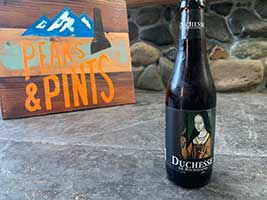 Verhaeghe Duchesse de Bourgogne
Verhaeghe Duchesse de Bourgogne
6.2% ABV
FLANDERS RED: Originally from Belgium’s Flanders region, Flanders red, also known as the Burgundies of Belgium, won’t destroy your cheeks like other sour beers from the country. This beer is brewed using large amounts of Munich and caramel malts with traditional brewing methods. The beer is then aged in large wooden barrels, vats, and foeders, then is inoculated with wild yeast and lactic acid-producing bacteria. The most important is the tradition of aging the red ales in huge vats of unlined oak. The wood, which cannot be sterilized, is home to dozens of wild yeast and bacterial strains that consume the residual sugars in the beer. Brewed by Belgian Brouwerij Verhaeghe, Duchesse de Bourgogne is a Flanders red ale, a blend of 8-month-old and 18-month-old ales, in this case. As with all red ales, the drink gets its characteristic sour and tart quality from lactic acid, while aging in oak barrels imparts a deeper body. The drink is named for Duchess Mary of Burgundy, a filthy-rich medieval heiress who suffered an unfortunate (and deadly) fall from her horse — it happens. This ruby-hued sipper boasts notes of tart plums, black cherries, and that funky, yeasty finish every sour fan demands.
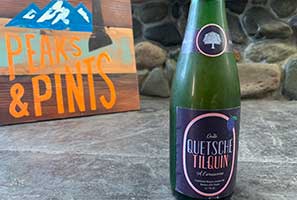 Tilquin Oude Quetsche Tilquin à l’ancienne 2019
Tilquin Oude Quetsche Tilquin à l’ancienne 2019
6.4% ABV
GUEUZE: Lambic originated more than 500 years ago in the Senne River Valley, south and west of Brussels, Belgium. Lambics are unique in that they are brewed with at least 30 percent unmalted wheat in addition to malted barley, preserved with aged hops, aged in oak barrels, and most differently, are spontaneously fermented. Gueuze (pronounced Gooze) isn’t a different beer but rather a blend of lambics of varying ages and provenances — usually a mixture of old (3 and 2 years old) and young (one year old) lambics — then re-fermented in the bottle. Perhaps the most famous gueuze brewery is Gueuzerie Tilquin. In 2009, a former bioengineer named Pierre Tilquin (it’s pronounced “till-CAN,” with a nasalized final vowel) founded the small family brewery based in Bierghes in Belgium’s Senne valley. Tilquin purchases worts from Boon, Lindemans, Cantillon and Girardin, then ferments them in their own oak barrels. This allows for the blending — typically 50 percent one-year old lambic, 30 percent two-year old lambic and 20 percent three-year old lambic. Quetsche Tilquin is a spontaneous fermentation beer obtained from the fermentation of destoned fresh purple plums in a blend of 1- and 2-year-old lambics for a period of 4 months. Unfiltered and unpasteurized, it is re-fermented in the bottle for a minimum period of 3 months. Plum brandy perfume hits the nose, followed by slight tartness, but also fruity and round. It also has a slight dryness from the skin of the plums.
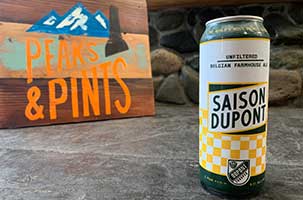 Brasserie Dupont Saison Dupont
Brasserie Dupont Saison Dupont
6.5% ABV
SAISON: Saisons, also known as farmhouse ales, dominated the summer farmlands of the French-speaking Wallonia region of southern Belgium in the 18th century. The refreshing, lower in alcohol ale provided refreshment to thirsty farm workers on hot days, thus the farmhouse connection. La Brasserie Dupont in Belgium has brewed this classic saison since 1844 on an actual farm. Saison Dupont seems, at first glance, to be a simple saison. The complexities, however, are nearly endless. There is an inherent sweetness that is counter-balanced by an earthy taste. Dry and bitter with a fruity aroma, it’s also brewed to keep re-fermenting in its bottle. Dupont follows the tradition of brewing in the winter and setting aside until spring, but you can find it year-round at Peaks & Pints.
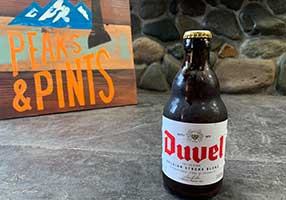 Duvel
Duvel
8.5% ABV, 33 IBU
BELGIAN STRONG GOLDEN ALE: Duvel Moortgat’s Belgian is considered the archetype of the Belgian strong golden ale category. The yeast — the fruity esters, imparts the distinctive characteristics of any Belgian beer and spicy phenols created during fermentation are the major draw for drinkers. Anyone looking for these traits in Duvel will not be disappointed. Duvel is brewed with Pilsner malt and dextrose, and hopped with Saaz and Styrian Golding, the yeast still stems from the original culture of Scottish yeast bought by Albert Moortgat during a business tour of the U.K. just after World War I. The nose is an equal, subtle blend of white pepper, coriander, tangerine peel, and pear juice; the flavor mixes spice rack stuff (coriander, clove, and white pepper) with sweet blasts of pears and apples before a slightly drying, bread-y finish.
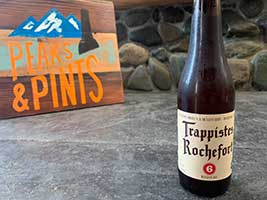 Abbaye Notre-Dame de Saint-Remy Trappistes Rochefort 6
Abbaye Notre-Dame de Saint-Remy Trappistes Rochefort 6
9.2% ABV, 22 IBU
TRAPPIST ALE: Abbaye Notre-Dame de Saint-Remy, which sits in a large valley close to Rochefort in the province of Namur, in Belgium, is home to a community of Trappist monks (Cistercians of the Strict Observance). The three brown ales produced by the abbey under the Brasserie de Rochefort name — Rochefort 6 (dubbel), Rochefort 8 (Belgian strong dark ale) and Rochefort 10 (quadruple) — can be tasted in the nearby town of Rochefort and all over the world. Rochefort Trappist 6 is named after its original gravity measured in “Belgian degrees” — a brewing scale no longer used today. It was first sold to the public in 1953. Bottle-conditioned for soft natural carbonation, and the oldest of the three Rochefort Trappist beers, Rochefort 6 has the reddish color of autumn leaves, a soft body, and an earthy, herbal palate (a hint of Darjeeling tea), which develops into a deep fruitiness. Refined, soft spiciness in the bouquet finishes with a bit caramel.
LINK: Peaks & Pints cooler inventory
